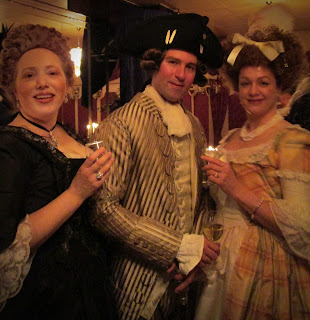This is the first proper 18th century shift I have made for myself, my last one was hobbled together and never really fit right. Since I'm going to making a GRAND 18th century outfit this year, it was time to redo everything from the skin out.
First of all, I really like how the major pattern companies are allowing historical costumers to create pretty historically-accurate patterns for the home sewist. It makes life so much easier! This pattern is no exception.
It went together easily for me (I've made similar styles before) but I thought I'd share a few tips for anyone making a shift for the first time:
- Transfer every single pattern tissue mark onto your fabric as you are cutting out your fabric--mark every dot or circle and clip those notches. This will save you many headaches, especially as you are essentially putting together squares and rectangles and not anything that looks like a modern sleeve. You will need those dots and clips, trust me!
- If you plan on using an overlock on your raw edges, serge each piece separately before assembling the pieces together. Many seams can not be serged after being sewn together because of the way it's constructed (again, squares & rectanges!). This is a great way to practicet turning corners on your serger. :)
- Since there are gussets along the side seams, let the garment hang on a hanger overnight before hemming just in case there is any stretching at the hem. There will most likely be some hem adjustments to be made anyway--the gusset pieces usually end up being longer than the front and back pieces.
It's important to note that even though I used my normal top pattern size, the shift turned out large. After putting my stays on (photos in my next post) it didn't look too bad but if I make it again (and I'd like to) I will definitely go down a size, possibly two. Yes, you need to be able to move but there is a lot of excess fabric right now that could be removed from my torso. The sleeves also seem long to me, especially since so many 18th century gowns have sleeves that are right below the elbow. I hope I don't have to stuff the sleeve up into whatever garment I'm wearing!
Overall I'd recommend this pattern to anyone with some sewing experience, just check the sizing and remember that you *do* need to hem this pattern.:)
I made this out of a linen/ramie blend that I bought for $2/yd in the Los Angeles garment district a few years ago. Right now it's pretty stiff but I'm hoping that it will soften up a bit with washings. The directions recommend silk organza for the ruffle at the neckline (that would have been very pretty) but I just made mine out of the smock fabric. I LOVE starched white linen, and this is no exception. I can't wait to get my new outfit together so that I can wear it! Plans, plans, plans.


















